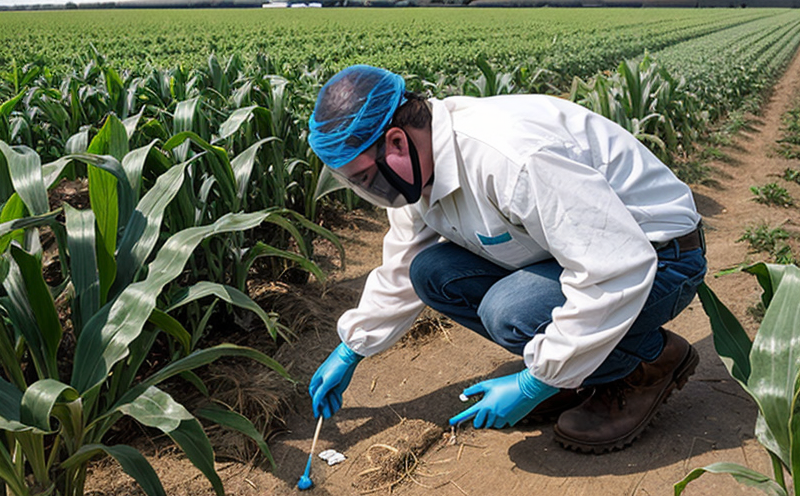Simazine Residue Testing in Crops
Simazine is a broad-spectrum herbicide used primarily to control annual grasses and broadleaf weeds. It works by inhibiting photosynthesis, which leads to the death of the plant. The safe use of simazine requires accurate monitoring of its residue levels in crops to ensure compliance with regulatory standards and food safety guidelines. This section focuses on the testing methods employed for detecting simazine residues in agricultural products.
The analysis involves a series of steps that are crucial for ensuring reliable results. The first step is sample preparation, which includes extraction techniques such as QuEChERS (Quick, Easy, Cheap, Effective, Rugged, and Safe) or solvent-based methods like hexane extraction followed by cleanup using solid-phase extraction cartridges. Following this, the extracts undergo purification steps to remove impurities.
The purified samples are then ready for analysis through instrumental techniques such as Gas Chromatography-Mass Spectrometry (GC-MS), Liquid Chromatography-Tandem Mass Spectrometry (LC-MS/MS), or High Performance Liquid Chromatography (HPLC). These methods provide high sensitivity and selectivity needed to detect trace levels of simazine. The instrument settings are optimized according to international standards, including ISO 3696:2017 for pesticides in food.
Once the samples have been analyzed, the data is processed using statistical software packages like SPSS or R to determine compliance with regulatory limits specified by bodies such as the European Union's Maximum Residue Levels (MRLs) outlined in Commission Regulation (EU) No 396/2015.
It is important to note that while simazine can be effective at controlling weeds, overuse or improper application practices could lead to unacceptable residues in crops. Therefore, regular monitoring through residue testing helps maintain both environmental integrity and consumer safety standards.
| Extraction Method | Description |
|---|---|
| QuEChERS | A rapid sample preparation procedure that combines extraction, dispersive cleanup, and reconstitution into a single step. |
| Solvent-Based Extraction (Hexane) | Involves using hexane to extract simazine from the sample followed by further processing steps depending on the intended analysis method. |
| Method | Description |
|---|---|
| GC-MS | Analyzes volatile compounds by separating them based on their retention times in a gas chromatograph before identifying them via mass spectrometry. |
| LC-MS/MS | A powerful combination of liquid chromatography followed by tandem mass spectrometry that offers enhanced detection capabilities for trace contaminants like simazine residues. |
- Sample preparation is critical to ensure accurate results.
- The choice of extraction method depends on the matrix type (e.g., leaf, grain).
- Instrumental methods provide precise quantification necessary for regulatory compliance.
Understanding these processes not only ensures accurate testing but also contributes significantly towards sustainable agricultural practices by helping farmers make informed decisions regarding pesticide use.
Benefits
The implementation of simazine residue testing offers numerous advantages to stakeholders within the agriculture sector. For quality managers, it provides peace of mind knowing that their products meet stringent safety and regulatory requirements. Compliance officers benefit from having robust data that supports legal defense against potential claims related to non-compliance issues.
R&D engineers can leverage this information to refine formulations or develop new applications for simazine that minimize environmental impact while maintaining efficacy. Procurement teams gain confidence in sourcing materials that adhere to international standards, thereby reducing risks associated with non-conforming goods entering supply chains.
By adhering strictly to prescribed protocols outlined by organizations such as the World Health Organization (WHO) and Food and Agriculture Organization of the United Nations (FAO), laboratories involved in simazine residue testing play a vital role in safeguarding public health and environmental quality worldwide.
Environmental and Sustainability Contributions
Simazine residue testing contributes positively to environmental sustainability by promoting responsible pesticide management. Farmers who adhere to recommended dosages based on accurate test results reduce risks of contamination from overuse or misuse.
Through precise monitoring, they can optimize application rates which leads to reduced usage overall. This approach supports biodiversity preservation as it minimizes harm to beneficial insects and other wildlife present in treated areas.
- Promotes responsible pesticide management
- Reduces risks of contamination from overuse or misuse
- Optimizes application rates leading to reduced usage
- Supports biodiversity preservation by minimizing harm to beneficial insects and wildlife
Use Cases and Application Examples
Simazine residue testing finds applications across various scenarios where compliance with regulatory limits is paramount. One such scenario involves monitoring post-harvest handling practices which might introduce additional residues into the food chain.
- Post-harvest handling: Ensuring that storage conditions do not inadvertently increase simazine levels in harvested crops.
- Crop rotation planning: Helping farmers plan rotations effectively to avoid carryover effects from previous applications of simazine.
In another case, this testing serves as a key component during export certification processes ensuring that exported agricultural products comply with importing countries' regulations regarding maximum allowed residue levels.
| Use Case | Description |
|---|---|
| Post-harvest Handling Monitoring | Ensuring that storage conditions do not inadvertently increase simazine levels in harvested crops. |
| Crop Rotation Planning | Aiding farmers in planning rotations effectively to avoid carryover effects from previous applications of simazine. |





